Chapter 12
Ground Control to Ballet Dancer
In This Chapter
 Jumping in place and across the floor
Jumping in place and across the floor
 Sautés aren’t just for mushrooms
Sautés aren’t just for mushrooms
 Doing the Can-Can
Doing the Can-Can
 Desperately seeking sissonne
Desperately seeking sissonne
In this chapter you are going to explore your abilities to defy gravity, and feel airborne, even if it’s just for a second or two. Jumping is one of the greatest thrills in ballet.
Before attempting to jump, however, we strongly suggest that you cover some of the earlier chapters in this book. Chapters 6 through 11 help you build the strength and coordination that you need for jumps.
Of course, like everything else in ballet, jumping takes practice. But when you’re flying gracefully through the air, you’ll be glad you know how to land.
Small Jumps on Two Legs (Petit Allegro)
First things first. Petit allegro (“puh-TEET a-LEG-row”) refers to the category of small jumps that dancers master before they attempt those breathtaking leaps.
In the simplest jump, called a sauté (“soh-TAY”), you stand on both legs, jump — but not too high — and return to both legs. We’re pretty sure you can handle this challenge.
In first position
This is the easiest position in which to experience the thrill of momentary weightlessness. You can concentrate on the coordination of bending and straightening your knees, pointing your feet while jumping, and the inevitable landing. Through all this, your arms and legs stay in one position, freeing your mind to focus on the jump.
.jpg)
1. Do a demi-plié (as shown in Figure 12-1a).
2. Do a relevé and return to the demi-plié.
See Chapter 6 for more information on the relevé.
Repeat this as many times as you want — up, down, up, down. Shake out your legs to rest.
Now you’re ready to jump.
3. From the demi-plié, push as if you are going to do a relevé — but this time, let your feet leave the ground. As you do, straighten your knees and point your feet (Figure 12-1b).
4. When you land, immediately bend your knees into a demi-plié — that’s your shock absorber. Now straighten your knees again to finish.
Congratulations: your first sauté.
|
Figure 12-1: Sauté in first position: First-position demi-plié (a); the jump with pointed feet (b). |

|
.jpg)
Ready to increase your endurance? Try this same sequence, but without the four-count rest between repetitions.
What’s that you say? You want more? Try doing three jumps in a row. After you land the third time, straighten your knees and do a demi-plié, ready to jump three more times. Then shake out your legs and stretch out those calf muscles.
In fifth position
The petit allegro jump in fifth position is known as a soubresaut (“soo-bruh-SOH”). The difficulty of this jump lies in trying to keep your legs together in the air.
.jpg)
1. Do a demi-plié in fifth position, right foot in front (Figure 12-2a).
2. Jump and cross your feet just a little bit more, so that the toes of one foot are directly in front of the toes of the other (Figure 12-2b).
This masochistic little move is known as “fifth position in the air.”
.jpg)
As you jump, make sure to use your abdominal muscles to keep your feet from moving behind you in the air. If your feet get behind you, you could strain your lower back muscles on the landing.
3. As you prepare to land, open your feet just slightly to land in a fifth position demi-plié; then straighten your knees.
Repeat this jump six more times — then do a battement tendu with your right leg to the side, and close it behind your left leg in fifth position. Now you’re in position to repeat the entire sequence with your left foot in front.
|
Figure 12-2: Soubresaut: Fifth-position demi-plié (a); the jump, with feet crossed (b). |

|
After you practice this step a few times, try a little variation on it. Starting with your feet in fifth position with the left foot in front, move diagonally forward ever so slightly with each jump — from D-6 to D-2 — and keep your arms in third arabesque arm position. (For more on the arabesque arm positions, see Chapter 9. But note: only the arms are in arabesque here — not the legs.) This is a move from the ballet Giselle, and if you feel inspired, we suggest that you try dancing it to the music from the pas de deux in Act I of that ballet.
Changing your feet during the jump
Your challenge, if you choose to accept it, is to change the position of your feet as you jump. This move, known in French as a changement de pieds (“shahnj-MAHN duh pee-AY”), is the starting point for the beating of your legs — that virtuosic flapping motion that the pros do. There are several ways to change feet while jumping, and this is your chance to practice the first stages of several different jumps.
Fifth to fifth
.jpg)
1. Do a demi-plié (Figure 12-3a).
2. Now jump, opening your legs into first position in the air (Figure 12-3b).

Remember to straighten your knees and point your feet fully in the air.
3. Land in fifth position with your left foot in front, and go into a demi-plié (Figure 12-3c).
There you have it — a changement de pieds.

If you want to put a fine point on your changement de pieds, you can add a little move of your head. In pure classical jumping technique, your head should always turn slightly in the direction of your forward foot. That is, if your right foot is in front, you turn your head slightly to the right. When you change feet in the air, your head should follow — subtly, of course, to avoid becoming airsick, which would be decidedly unballetic.
|
Figure 12-3: Changement de pieds: Fifth-position demi-plié (a); the jump (b); the land- ing (c). |

|
Fifth to second and back (petit échappé)
In Chapter 8, we tell you about a little move called the échappé. The petit échappé is nothing more than an échappé with two jumps attached.
.jpg)
1. Do a demi-plié (Figure 12-4a).
2. As you jump, immediately open your legs into second position, and bring your arms up through middle fifth to second position (Figure 12-4b).
3. Land in a second position and do a demi-plié (Figure 12-4c).
4. Now push off into another jump, and change your legs into fifth position with your left foot in front, bringing your arms back to low fifth position (Figure 12-4d).
That was one handsome looking petit échappé .
|
Figure 12-4: Petit échappé: Fifth-position demi-plié (a); opening the legs in the jump (b); the landing (c); the second landing, feet in fifth position (d). |
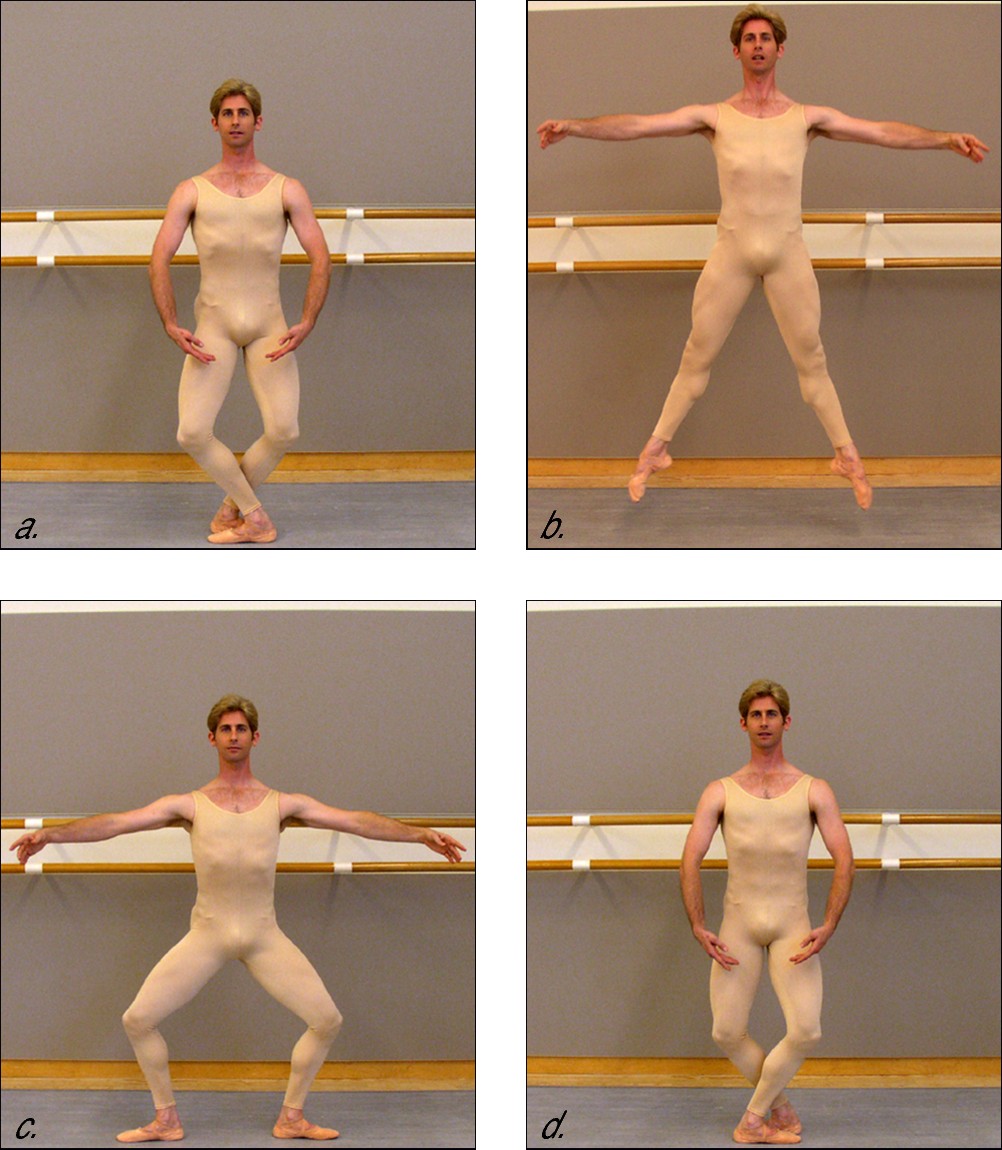
|
Repeat this move several more times, with a rest in between. When that seems easy, try doing several of them in a row without a rest.
Want more? Try alternating the petit échappé with the changement de pieds: one échappé, one changement de pieds, one échappé, one changement de pieds, and so on. Finally, finish with two changements de pieds, then repeat all this to the other side. If you feel like using music for this combination, we suggest the Polonaise from Tchaikovsky’s Swan Lake.
The grand échappé
In this section on small jumps, we’d like to introduce you to one larger one. The grand échappé is just like the petit échappé — but bigger.
In performance, this step is usually danced by men, because it has a heavy, macho look. You may need almost twice the force for this jump that you use in the smaller jump. But imagine how much more you can do in the air with that added height.
.jpg)
Start in fifth position with your right foot in front, arms in low fifth position.
1. Do a demi-plié.
Refer to Figure 12-4a.
2. Now jump — high! Bring your legs into fifth position in the air, and bring your arms to middle fifth position.
3. Now open your legs and arms into second position in the air (see Figure 12-5).
4. Land and do a demi-plié (as in Figure 12-4c). Now push off again with enough force to sustain second position in the air for a moment.
5. Close your left foot in front in fifth position in the air; then land and do a demi-plié.
Refer to Figure 12-4d.
|
Figure 12-5: The grand échappé: second position in the air. |
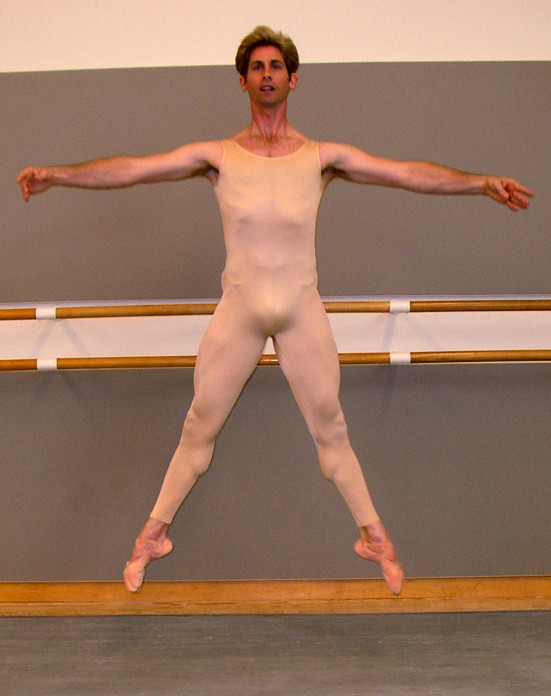
|
Small Jumps on One Leg (More Petit Allegro)
After you experience the excitement of jumping from two feet (see the previous section), you may want to attempt to jump from one foot. In these jumps there are many ways to land — on the same foot, on the other foot, or on both feet.
Pushing off and landing on one leg (temps levé)
Jumping repeatedly on the same foot (temps levé — “tahn luh-VAY”) is extremely easy to describe — and extremely challenging to do. The difficulty is not in the technique, but in the strength and endurance that you need to be a human pogo stick.
.jpg)
1. Do a demi-plié, and then jump.
2. Land on your right leg, with your left leg in cou-de-pied back position (Figure 12-6a).
3. Keeping your left foot where it is, jump straight up with your right leg, straightening your right knee and pointing your right foot fully (Figure 12-6b).
4. Land on your right leg, and do a demi-plié on your right leg.
5. Push off your right leg again, and land back on both feet in first position.
6. Do a demi-plié and straighten your knees.
Repeat this step to the other side, with your right leg in the cou-de-pied back position — and then repeat both sides again.
|
Figure 12-6: Temps levé: The first landing on the right leg, left leg in back cou-de-pied position (a); the second jump ( b). |
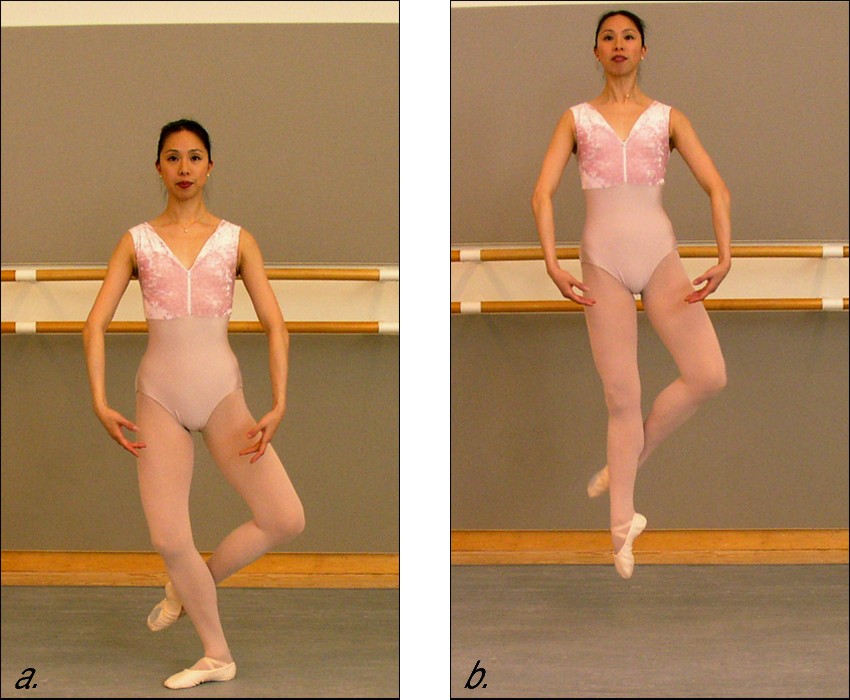
|
.jpg)
After you get the feel for this jump, why not try it to music? We suggest using the Scherzo movement from Mendelssohn’s Midsummer Night’s Dream.
In attitude (emboîté)
In this step, the emboîté (“ahm-bwah-TAY”), you jump from one leg and land on the other, while keeping your raised leg in attitude (for much more on attitude, refer to Chapter 8).
The emboîté resembles that old French cabaret step, the Can-Can — with the exception that your legs are turned out, and your feet pointed.
.jpg)
1. Brush your right foot out to attitude front. Bring your arms halfway between low fifth and second position and do a demi-plié (Figure 12-7a).
2. Push up off your left leg. In the air, switch legs — so that your left leg is now in attitude, and your right leg is straight with a pointed foot (Figure 12-7b).
3. Keeping the left leg in attitude, land on your right leg and do a demi-plié (Figure 12-7c).
Now do another emboîté to the other side.
Want to put this step to music? Nothing’s more appropriate than the Can-Can from Offenbach’s La vie Parisienne. Start by taking two counts for each emboîté, and when the movement becomes really fluent, do one per count.
Brushing Your Feet into a Jump
When you practice at the barre, one of the first exercises you do is the battement tendu — brushing one foot along the floor (see Chapter 6 for more information on the battement tendu ). You can create an immense amount of force with this brushing motion. Doing a battement tendu is like loading a slingshot. If you then release your leg into the air, your body has little choice but to follow. Trust the force, and you too can be a skywalker.
Brushing and joining your feet in the air (pas assemblé)
The pas assemblé (“PAH ah-sahm-BLAY”) is similar to the soubresaut (see “In fifth position,” earlier in this chapter) — except that your feet are at a slight angle.
|
Figure 12-7: Emboîté: The prepara- tion in attitude (a); changing the legs in the air (b); the landing on the right leg (c). |
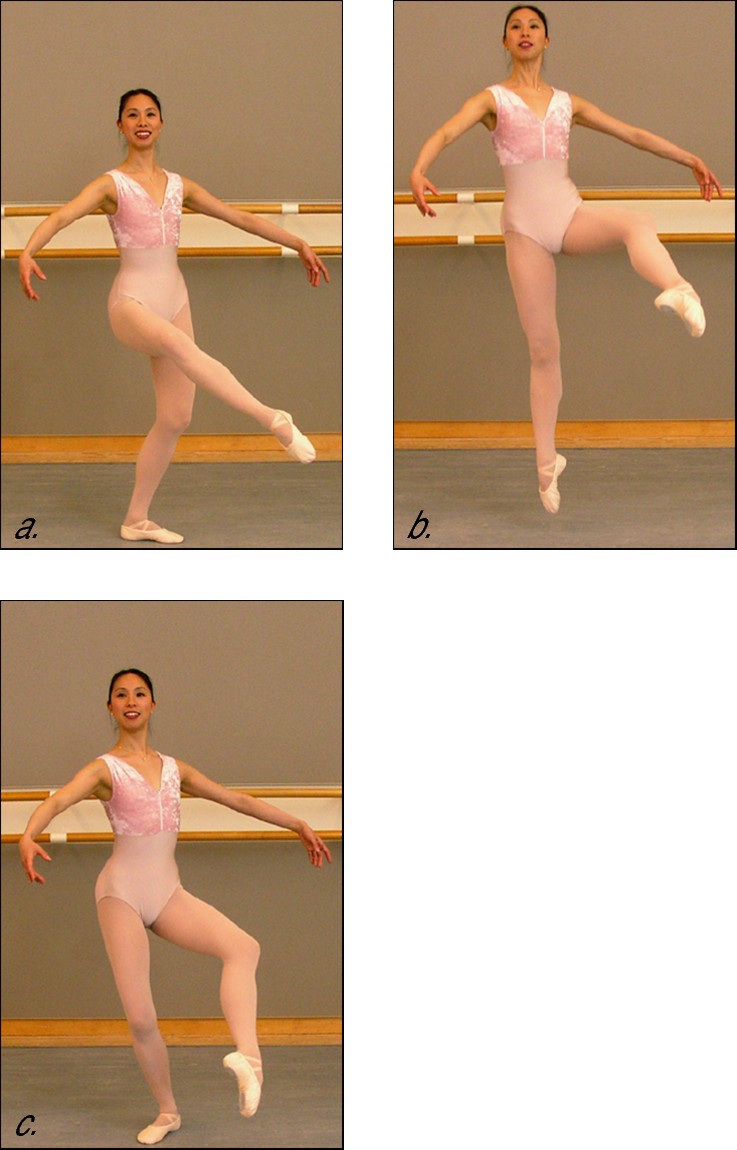
|
.jpg)
1. Do a demi-plié. Now brush your right leg in dégagé to the side (Figure 12-8a).
2. Jump off your left leg and lift your left leg up to meet your right leg — assembling your legs in the air. Your left leg should be crossed in fifth position in back (Figure 12-8b).
3. Land in fifth position with your right foot in front, and do a demi-plié (Figure 12-8c).
This jump should not travel, but simply go straight up and down.
Now try repeating the step to the left.
How about doing this step to music? For a change of pace, try Scott Joplin’s Maple Leaf Rag.
|
Figure 12-8: Pas assemblé: The prepara- tion (a); the jump — some assembly required (b); the land- ing (c). |

|
Brushing, drawing a 4, and landing on one leg (pas jeté)
In the pas jeté (“PAH juh-TAY”) you brush one foot, then jump, keeping one leg straight while the other leg bends and touches the straight leg behind the calf. This unique step creates the shape of a “4” in the air — try that the next time you have to deliver a financial report.
.jpg)
1. Do a dégagé with your right leg to the side while you demi-plié on your left leg, and bring your arms into low fourth position with your right arm in front (Figure 12-9a).
2. Push off your left leg into the jump. As you leave the floor, bring your left leg into the cou-de-pied position behind your right leg (Figure 12-9b).
3. Maintain this position as you land, and do a demi-plié on your right leg, keeping your arms in low fourth position (Figure 12-9c).
Now try this jump to the left, and change your arms to low fourth position with your left arm in front, as you brush your left leg to the side.
|
Figure 12-9: Pas jeté: The take- off (a); the jump, creating a number 4 in the air (b); the land- ing (c). |
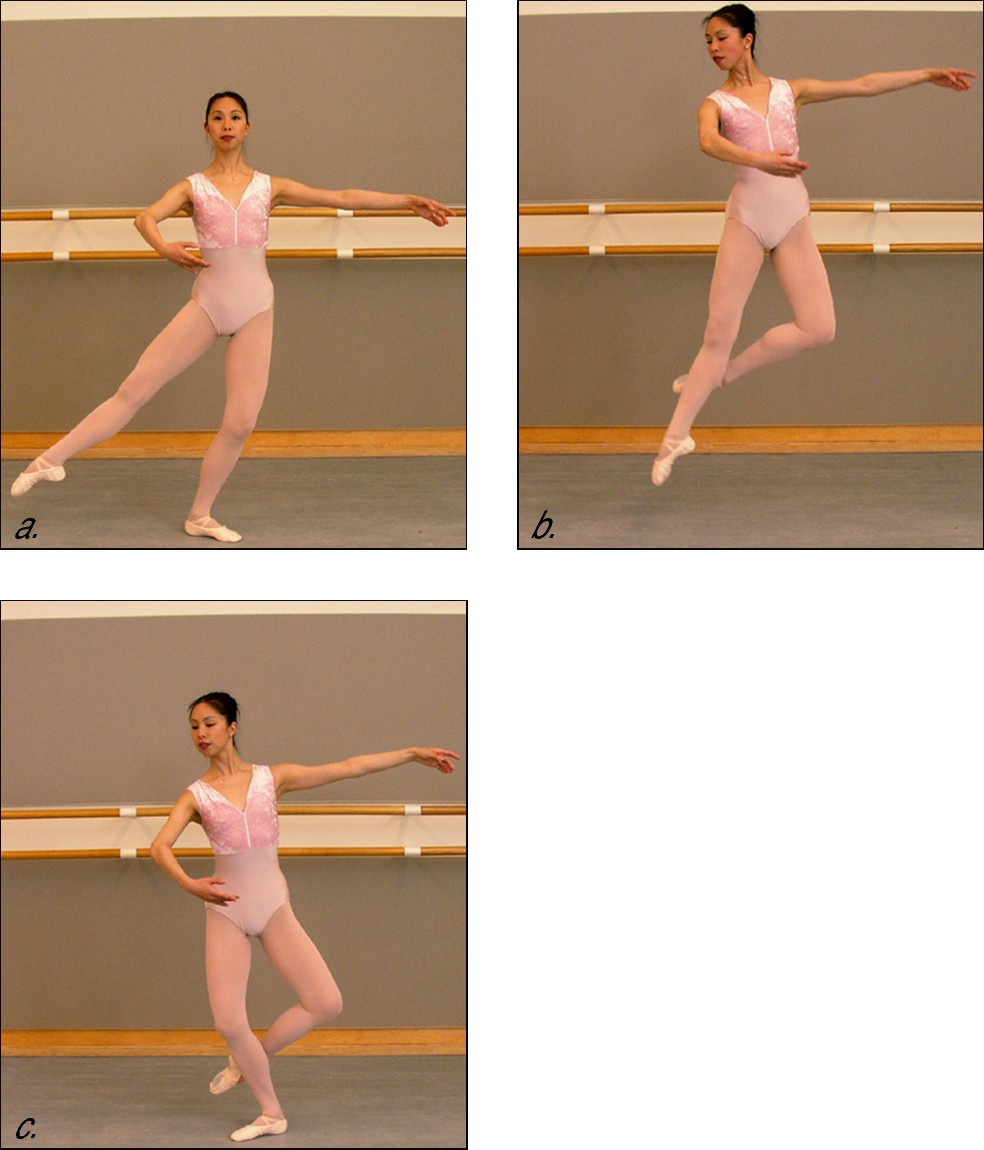
|
Traveling Jumps
All the jumps described so far in this chapter, on one or two legs, have something in common: They go straight up and down. After you feel completely comfortable with these jumps, you can start to jump in different directions as well — traveling, as they say in the ballet biz.
.jpg)
The cat step (pas de chat)
In Chapter 7 we show you the pas de cheval , or horse step. That’s not the only step that takes its inspiration from the animal kingdom.
Cats are admired for two abilities, which far exceed our own: licking themselves and jumping. Though the first of these abilities doesn’t come up often in ballet, the second certainly does. These flexible little animals have inspired two jumping steps: the cat step (pas de chat — “PAH duh SHAH”) and the Big Honking Cat Leap (grand saut de chat — “GRAHN SOH duh SHAH”) — okay, that’s not a direct translation. For now, we want to stick to the pas de chat, and save the larger leap for Chapter 13.
.jpg)
1. Stand facing D-1, in fifth position with your left foot in front, arms in low fourth position with your right arm in front.
2. Lift your right leg into retiré as you do a demi-plié on your left leg (Figure 12-10a).
3. Push off your left leg into the air, and bring your left leg into a retiré position (Figure 12-10b).
Notice that you’re making a diamond shape with your legs.
4. Land on your right leg, maintaining your left leg in retiré (Figure 12-10c), and finish by closing your left leg in front of the right in fifth position (Figure 12-10d) — ready to repeat the whole step.
You can dance this step over and over in succession, all the way across the dance floor. Try it! For music, we recommend the ballet music from Verdi’s opera I vespri siciliani.
Traveling to the side and forward (pas de basque)
Like the waltz step that we show you in Chapter 11, this step has three components. What’s unique about the pas de basque (“PAH duh BAHSK”), though, is that it travels both sideways and forward — like a knight in the game of chess. Or like your Uncle Harry last St. Patrick’s Day.
.jpg)
1. Do a battement tendu with your right leg to the front, bringing your arms to middle fifth position (Figure 12-11a).
2. Do a demi rond de jambe (see Chapter 6) with your right leg to the side, and push off your left leg into the air, sideways to the right, with both legs extending into second position in the air. Meanwhile, open your arms to second position (Figure 12-11b).
Because you’re traveling to the right, you will land on your right leg first.
|
Figure 12-10: Pas de chat: The take-off (a); the position in the air (b); the landing on the right leg (c); the finish in fifth position (d). |
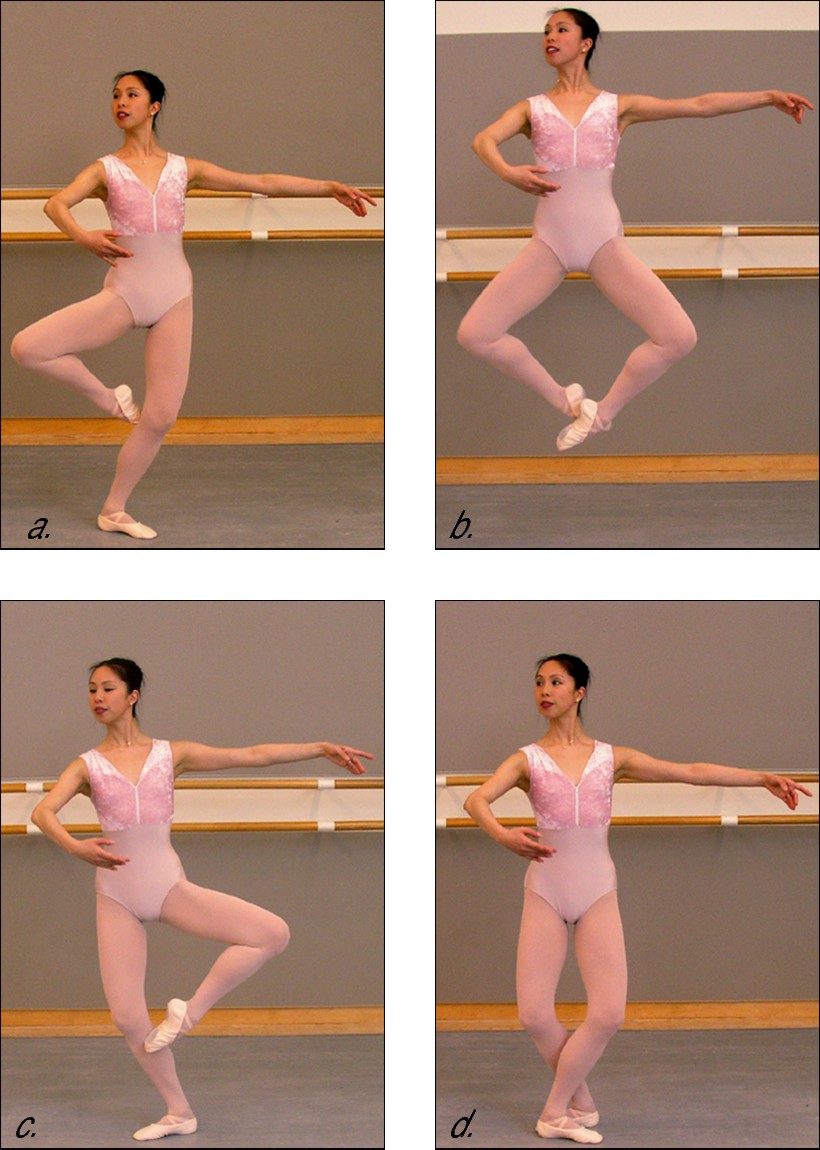
|
3. Close your left leg into a first-position demi-plié (Figure 12-11c).
4. Staying in the demi-plié, slide your left leg forward through fourth position, transferring your weight to the left leg and straighten it. Meanwhile, do a battement tendu with your right leg to the back, bringing your arms through middle fifth position, and open them into second position (Figure 12-11d).
5. To finish, close your right leg behind the left in fifth position, arms lowering to low fifth position (Figure 12-11e).
Now you’re ready to repeat the pas de basque starting with your left leg, traveling to the left and forward.
We’re pretty sure Basques never walked this way. But if you’d like to give this step a try to music, try the Braul movement from Bela Bartók’s Romanian Dances.
|
Figure 12-11: Pas de basque: the battement tendu to the front (a); second position in the air (b); first position following the landing (c); after the slide forward, in battement tendu to the back (d); the finishing position (e). |

|
Landing “closed” (sissonne fermée)
The sissonne (“see-SONE”) is a jump from two legs onto on one leg. In the sissonne fermée (“fair-MAY”), or “closed,” you land on one leg and then “close” the other into fifth position.
.jpg)
1. In fifth position with your right foot front, arms in low fourth position with your right arm in front, and do a demi-plié (Figure 12-12a).
2. Jump from both legs and travel to the right, opening your arms into second position (Figure 12-12b).
3. Land on your right leg, with your left leg still extended to the left side, arms in second position (Figure 12-12c).
4. Close your left foot in front of the right in fifth position, and bring your left arm in front to low fourth position (Figure 12-12d).
That’s all there is to it!
|
Figure 12-12: Sissonne fermée: the prepara-tion (a); the position in the air (b); landing on your right leg (c); closing the left leg after landing (d). |

|
After you understand the feeling, you are in position to do a sissonne fermée to the left.

If the spirit moves you, try doing a bunch of sissonnes set to music. We suggest the opening of the final movement of Tchaikovsky’s Suite for Orchestra no. 3 in G major. This is the music that the choreographer George Balanchine chose for his masterpiece Theme and Variations.
Landing “open” on one leg (sissonne ouverte)
The sissonne ouverte (“oo-VAYRT”), or “open,” is very similar to the sissonne fermée — with the exception that after landing, you hold your raised leg “open” for a second before closing it.
.jpg)
1. In fifth position with your right foot in front, arms in low fifth position, and do a demi-plié (Figure 12-13a).
2. Push off both legs, shooting your right leg forward as you lift your left leg back and bring both arms into a first position arabesque (Figure 12-13b).
You should travel forward on this jump.
3. Land on your right leg, keeping your left leg behind you, in arabesque; keeping your arms in first position arabesque (Figure 12-13c).
The open-legged landing of the sissonne ouverte gives you a wealth of options. As you stand there with your legs open, you can say to yourself, “Hmmmmm. What would I like to do now? Close my raised leg into fifth position? Go on to another step? Or hold this open position indefinitely?” This last option is useful if you’re onstage and your partner is taking too long in the dressing room.
Say that you decide to close your left leg behind your right in fifth position, with straight knees. (A good choice.) You can now do a demi-plié and repeat the sissonne ouverte to the right. After several repetitions to the right, do a few to the left.
.jpg)
.jpg)
1. Begin facing D-2. Dance four sissonnes ouvertes and a pas de bourré to the right, ending with your left foot in front.
2. Now turn your hips and torso to face D-8, and repeat the sequence to the left.
As ballet dancers have been saying for centuries: Vous cuisinez au gaz. (You’re cooking with gas.)
|
Figure 12-13: Sissonne ouverte: The starting position (a); the position in the air, in first position arabesque (b); the landing (c). |

|